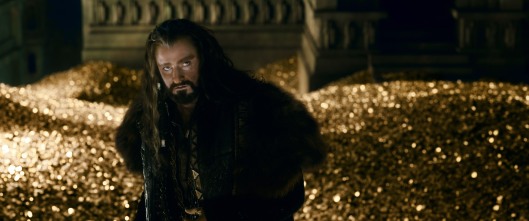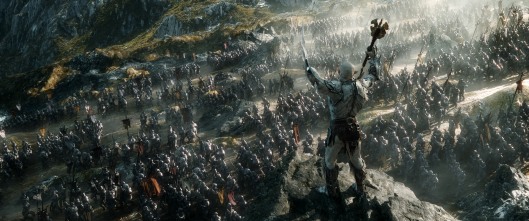Tags
Benedict Cumberbatch, J.R.R. Tolkien, Martin Freeman, movie review, Peter Jackson, Richard Armitage, The Hobbit: The Battle of the Five Armies, The Lord of the Rings
It’s over. “The Hobbit: The Battle of the Five Armies” brings to an end an overextended tale that could have easily been told in two films as Mexican director Guillermo del Toro originally conceived it before leaving the project. The final chapter of this sometimes exhilarating, always frustrating trilogy is evidence of that. It never reaches the giddy heights of “The Return of the King,” the final installment of the much better, more heartfelt, “Lord of the Rings” trilogy. It even pales next to the trilogy’s previous chapter “The Desolation of Smaug.” Nothing in “The Hobbit: The Battle of the Five Armies” compares to that wonderful cat and mouse game between Smaug and Bilbo in the last film (a scene I never get tired of watching every time “The Desolation of Smaug” is shown on cable TV).
“The Battle of the Five Armies” begins right where “The Desolation of Smaug” left off: with the dragon’s wanton destruction of Laketown. This opening sequence sets the tone for the rest of the film by giving equal weight to spectacle and a rather simplistic depiction of the human foibles that lead to or result from war. For ten minutes we see characters act heroically or cowardly, driven by greed or compassion. Voiced magnificently once again by Benedict Cumberbatch (in a less mannered and more nuanced performance than the one he delivers as Alan Turing in “The Imitation Game”), Smaug meets his end at the hands of Bard the Bowman (Luke Evans), setting the stage for the titular battle.
Elves and humans set their sights on the gold stashed inside The Lonely Mountain, home of the dwarf kingdom of Erebor, and an army or orcs seek to take over the Mountaiun, given its strategic value for their evil lord Sauron. Inside the mountain and the kingdom of Erebor, Thorin’s (Richard Armitage) small army of dwarves prepares for battle even though they are outnumbered.

Thorin (Richard Armitage) has succumbed to the same disease that afflicted his grandfather and his father: greed.
Copyright: ©2014 WARNER BROS. ENTERTAINMENT INC. AND METRO-GOLDWYN-MAYER PICTURES INC. (US, CANADA & NEW LINE FOREIGN TERRITORIES) ©2014 METRO-GOLDWYN-MAYER PICTURES INC. AND WARNER BROS. ENTERTAINMENT INC. (ALL OTHER TERRITORIES) ALL RIGHTS RESERVED
Photo Credit: Courtesy of Warner Bros. Pictures
Blinded by greed, Thorin will listen to neither rhyme nor reason, whether it comes from Bilbo (Martin Freeman) or from Bard who asks, on behalf of the habitants of Laketown, for remuneration for the damage caused by Smaug. Thorin has succumbed to the same disease that afflicted his grandfather and his father before him that led to the downfall of their kingdom. He has even grown paranoid as he begins to doubt his fellow dwarves’ loyalty. As Thorin, Armitage delivers an understated, even introspective, performance that almost gets lost amidst the noise and the plot complications.
Meanwhile, in Dol Guldur, home of the Necromancer (Sauron’s true identity), Gandalf (Ian McKellen), last seen imprisoned inside a cage, is rescued by three cast members of the “The Lord of the Rings” trilogy: elf queen Galadriel (Cate Blanchett), Elrond (Hugo Weaving) and Saruman (Christopher Lee in full ass-kicking Count Dooku mode). Gandalf knows he is running out of time and rushes back to the Mountain. Joining the fracas: Dain Ironfoot (Billy Connolly) and his army of dwarves. And from the top of a nearby mountain, guiding his growing army of orcs as if he were the Middle Earth version of General George S. Patton, stands Azog the Defiler, with whom Thorin has some history.
Thorin’s struggle with his “dragon disease,” and the gathering armies and power players behind them are not the only narrative threads director Peter Jackson and writers Fran Walsh, Philippa Boyens and del Toro (although I wonder how much of his input made it into this final chapter) weave into this tapestry. There is also the unrequited interspecies romance between elf warrior Tauriel (Evangeline Lilly, given little to do but mope, compared to the more Amazonian creature of the prior film) and dwarf Kili (Aidan Turner). Jackson also offsets the grimness and doom with some intentional, and unintentional, humor from the likes of Connolly and Ryan Gage as the sniveling, ass-kissing Alfrid. And what about poor Bilbo? Except for two pivotal scenes, he is sidelined throughout most of the film, not even given the chance to bear witness to the events unfolding in front of him.

Azog the Defiler leads his troops into battle in this scene from “The Hobbit: The Battle of the Five Armies.”
Copyright: ©2014 WARNER BROS. ENTERTAINMENT INC. AND METRO-GOLDWYN-MAYER PICTURES INC. (US, CANADA & NEW LINE FOREIGN TERRITORIES) ©2014 METRO-GOLDWYN-MAYER PICTURES INC. AND WARNER BROS. ENTERTAINMENT INC. (ALL OTHER TERRITORIES) ALL RIGHTS RESERVED
Photo Credit: Courtesy of Warner Bros. Pictures
The battle scenes are spectacular, as expected from Jackson. I personally enjoyed those scenes featuring Azog’s command of the battlefield; I found myself rooting for him instead of the good guys because, frankly, he was a far more interesting, better developed character in this final roundelay. But then, Jackson pulls out of his sleeve a deus-ex-machina that undermines what little excitement or sense of danger he had built up to that point bringing the whole edifice down.
I couldn’t also help but feel a sense of déjà vu watching this epic battle. In fact, we’ve been here before. With “The Return of the King,” Jackson set the bar high for other genre films by managing to conjure drama in the battlefield and making the epic, personal. We cared for these characters partly because we spent far more time with them, their stories were better developed, they didn’t feel like so much padding. Some of that film’s sequences –Legolas gliding up and down and around the giant elephants’ tusks and bodies, bringing them down with his arrows; Eowyn’s heroism in the battlefield– are downright unforgettable. “The Battle of the Five Armies” may have two or two great scenes but nothing with quite the emotional heft found in “The Return of the King.”

Reblogged this on jeannem441.